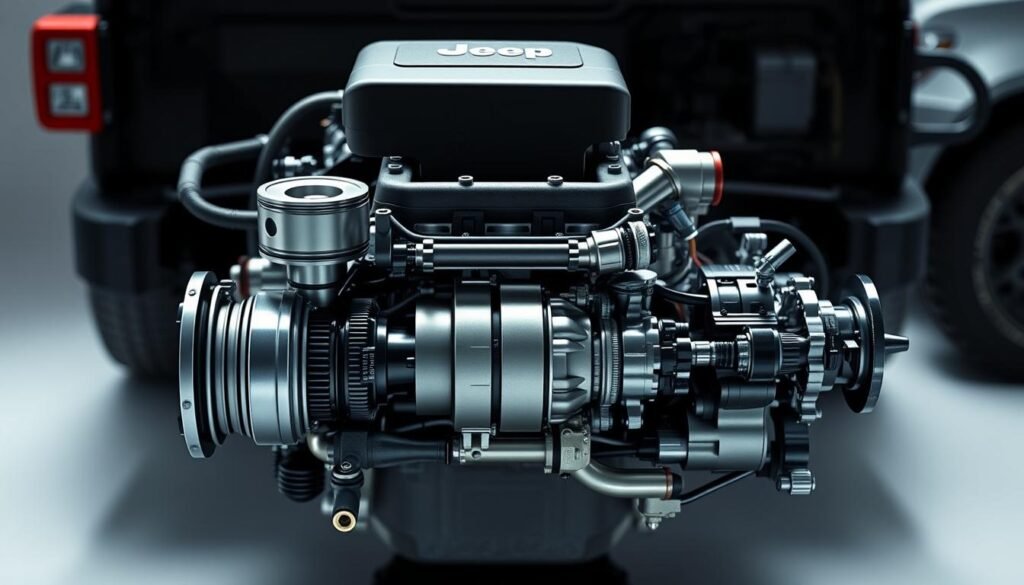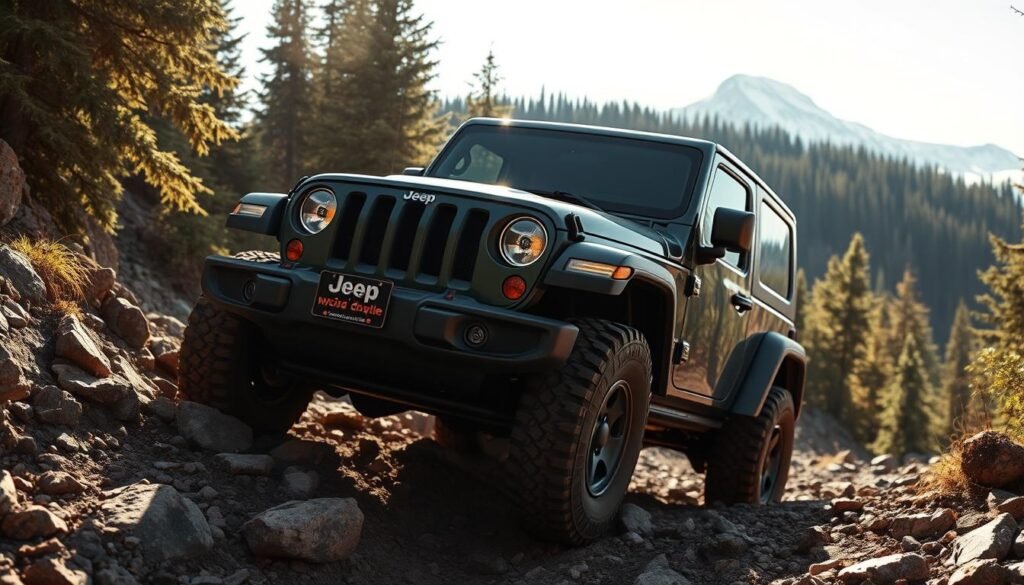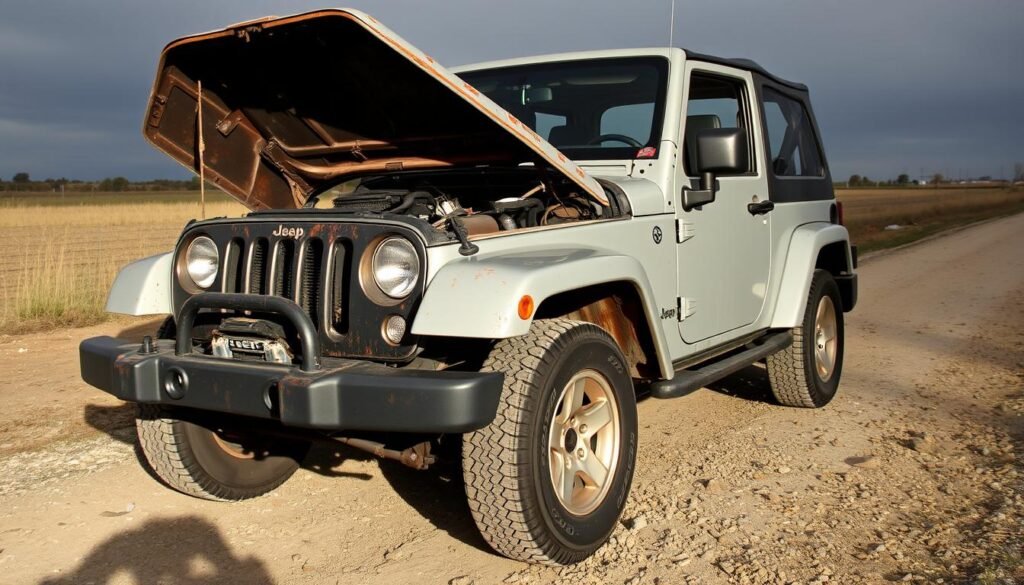The Jeep Wrangler EcoDiesel engine aimed for better fuel use and strong performance. But, it quickly became known for persistent Jeep EcoDiesel problems. Owners faced engine failures and electrical issues, which made the engine’s promise hard to keep.
Jeep has decided to stop using the EcoDiesel in 2024 Wranglers. This choice is due to the many EcoDiesel engine problems in recent models. It shows Jeep is taking a hard look at the engine’s reliability and performance.
Let’s dive into the world of Jeep’s diesel technology. We’ll look at the mechanical challenges, performance limits, and what it means for diesel off-road vehicles.
Jeep EcoDiesel Engine History
The Jeep EcoDiesel engine is a big step in diesel tech for off-road vehicles. It has changed a lot over the years. This has helped fix many problems and made it better.
The EcoDiesel’s story started with big goals. It aimed to be very fuel-efficient and strong. Each new version tried to make the engine better and solve old issues.
First Generation EcoDiesel Challenges
The first EcoDiesel engine had big problems:
- Frequent EGR cooler failures
- Camshaft durability concerns
- Limited reliability under extreme conditions
Second Generation Improvements
Jeep’s engineers made big changes for the second generation:
- Enhanced cooling system design
- Reinforced internal components
- Improved electronic management systems
Third Generation Development
The newest EcoDiesel is a big improvement. It has 260 horsepower and 442 lb-ft of torque. This version fixed many old problems and keeps great performance.
It has a stronger fuel injection system, better emissions control, and is more reliable. The third-generation EcoDiesel can go up to 80 miles more than gas engines. This makes it great for those who love adventure.
Common Jeep Ecodiesel Problems
Jeep Ecodiesel problems have been a big worry for many owners. The 3.0L EcoDiesel engine is powerful and efficient. But, it has faced several issues that buyers should know before buying.
Many owners have faced EcoDiesel problems in different areas. These issues can affect how well a Jeep with the EcoDiesel engine runs.
- Engine Performance Issues
- Excessive vibration
- Unexpected engine stalling
- Turbo lag
- Mechanical Complications
- Oil cooler failures
- Leaking exhaust couplers
- Water contamination in fuel system
- Electrical System Concerns
- Dashboard warning light malfunctions
- Wiring harness problems
- Electronic throttle control issues
Despite these challenges, the EcoDiesel engine remains attractive due to its impressive specifications. It has 260 horsepower and 442 lb-ft of torque. It also has the best towing capability of up to 7,400 pounds.
| Problem Type | Frequency | Potential Impact |
|---|---|---|
| EGR Cooler Failure | High | Potential engine replacement |
| Fuel System Issues | Moderate | Performance reduction |
| Electrical Malfunctions | Moderate | Intermittent vehicle operation |
The 3rd generation EcoDiesel has seen big improvements in reliability. Buyers should look into these Jeep Ecodiesel problems before buying.
Engine Performance and Power Issues
Jeep Ecodiesel Problems can really hurt how well your car runs, mainly in the early models. The 3.0-liter EcoDiesel V6 engine started in 2014. It faced big challenges that made it less reliable and less powerful.
Many Jeep EcoDiesel owners have faced issues that make driving hard and shorten their car’s life. These problems come from mechanical and system issues that need to be fixed.
Turbocharger Lag Problems
The EcoDiesel engine often has turbocharger lag, which makes the car less responsive. The engine makes about 230 HP at the wheels. It also has good torque, which should help with quickness.
- Reduced acceleration performance
- Delayed power delivery
- Potential turbocharger component wear
Oil Cooler Malfunctions
Oil cooler failures are a big worry for EcoDiesel engines. These problems can cause serious damage, like:
- Mixing of engine oil with coolant
- Potential main bearing failure
- Increased risk of internal engine damage
Exhaust System Complications
Early EcoDiesel models have exhaust system issues, including:
- Exhaust gas recirculation (EGR) cooler cracks
- Potential coolant leaks
- Risk of overheating
Even with these problems, some owners have used their cars for over 300,000 miles. Jeep made changes to fix many of these issues. They stopped making EcoDiesel engines by 2020.
Critical CP4 High Pressure Fuel Pump Issues

Jeep Ecodiesel owners face big problems with the CP4 fuel pump. This pump was made for European diesel engines but has major issues in American cars.
- It works under very high pressures (up to 36,000 psi)
- It pumps fast, at 6,000 rpm
- It’s not good with ultra-low sulfur diesel fuel because it lacks lubricity
Car owners notice many signs of CP4 fuel pump trouble, like:
- Hard to start the engine
- Big power loss
- Rough idling
- More fuel used
The pump’s design leads to a high failure rate, often before it hits 100,000 miles. Stellantis knows about these Jeep Ecodiesel issues. About 60,000 cars might need a recall.
To avoid CP4 fuel pump failures, use good fuel additives and keep up with maintenance. Diesel car owners should watch for early signs and fix them fast to avoid expensive repairs.
Electrical System Failures and Warning Signs
Jeep Ecodiesel electrical issues can be tough for owners. It’s important to know how the electrical system works. This helps keep your vehicle running well and safely. Look out for warning signs of electrical problems.
Modern cars, like the Jeep Ecodiesel, have complex electrical systems. Drivers might see warning lights that show electrical issues. These signs should not be ignored.
- Battery charging malfunctions
- Wiring harness degradation
- Electronic throttle control complications
Dashboard Warning Lights
Dashboard lights are key to knowing your car’s health. Knowing what these lights mean can help avoid big problems and expensive fixes. Learn about them to keep your car running smoothly.
| Warning Light | Potential Issue | Recommended Action |
|---|---|---|
| Battery Warning | Charging System Malfunction | Check electrical connections |
| Engine Temperature | Overheating Risk | Stop and inspect cooling system |
| Oil Pressure | Low Lubrication | Immediate engine shutdown |
Wiring Harness Concerns
Wiring harness problems often cause electrical issues in Jeep Ecodiesel cars. Friction, heat, and vibration can damage electrical connections. This can lead to problems that stop the car from working right.
Electronic Throttle Control Problems
The electronic throttle control is key for a car’s performance. If it fails, the car might not accelerate right. This can be dangerous for Jeep Ecodiesel owners.
Proactive maintenance is the key to preventing electrical system failures in your Jeep Ecodiesel.
Transmission and Drivetrain Complications

Jeep Ecodiesel problems often show up in the transmission and drivetrain. This can be a big challenge for car owners. The ZF 8-Speed transmission, used in these vehicles, has known issues that can affect how well the car runs.
Some common transmission problems for Jeep EcoDiesel cars include:
- Solenoid failures affecting gear shifting
- Valve body complications
- Torque converter problems
- Clutch pack malfunctions
EcoDiesel transmission issues can be tough because of the complex parts inside. About 66% of ZF 8-Speed transmissions face bushing problems during remanufacturing. The valve body, which controls 8 forward gears, is a common failure point.
Owners should watch for warning signs like:
- Rough or delayed gear shifting
- Unusual transmission noises
- Unexpected performance drops
- Transmission warning lights
Preventative maintenance is key. Regular fluid checks and timely service can help avoid big transmission problems. Experts say to get professional inspections every 30,000 miles to find issues early and avoid expensive fixes.
The complexity of modern diesel transmissions requires specialized diagnostic skills and proactive maintenance strategies.
EGR System and Cooling Problems
Jeep Ecodiesel owners face big challenges with the engine’s Exhaust Gas Recirculation (EGR) system and cooling. EcoDiesel cooling issues can really hurt how well the vehicle runs and how long it lasts.
Diesel engines today need advanced cooling and emissions systems. The EGR system is key to cutting down on harmful emissions. But, it can also cause big problems for Jeep EcoDiesel owners.
EGR Cooler Failures
EGR cooler failures are a big worry for diesel engine owners. Signs include:
- White steam or smoke from the exhaust
- Unexplained coolant level drops
- External coolant leakage
- Activated check engine light
Temperature Management Issues
Extreme temperatures can really hurt the EcoDiesel engine. Engine coolant temperatures can reach over 240 degrees Fahrenheit under heavy towing conditions. This puts a lot of stress on the cooling system.
Prevention and Maintenance Tips
Keeping up with maintenance is important to avoid Jeep Ecodiesel Problems. Here are some tips:
- Regular system inspections
- Monitor coolant levels and quality
- Check for early warning signs of EGR cooler issues
- Consider supplemental cooling solutions
The Bullet Proof Diesel Supplemental Radiator is a great fix for extreme temperatures. It’s perfect for Jeep Wrangler and Gladiator EcoDiesel models from 2020 onwards.
Benefits and Drawbacks of the EcoDiesel Engine

The Jeep EcoDiesel engine is a special powertrain that offers both great benefits and challenges. Knowing about Jeep Ecodiesel problems helps buyers make smart choices.
Key advantages of the EcoDiesel engine include:
- Exceptional fuel efficiency with 22 MPG city and 29 MPG highway
- Robust torque output of 442 lb-ft at 1,400 rpm
- Improved long-distance driving range
- Enhanced off-road performance capabilities
The EcoDiesel engine has both pros and cons. It beats gasoline engines in fuel economy but costs about $4,000 more.
| Performance Metric | EcoDiesel | Standard V6 |
|---|---|---|
| Horsepower | 260 hp | 285 hp |
| Torque | 442 lb-ft | 260 lb-ft |
| Fuel Economy (Combined) | 25 MPG | 20 MPG |
Potential drawbacks include higher maintenance costs, complex emissions systems, and reliability concerns. Owners should weigh these factors before choosing an EcoDiesel vehicle.
Maintenance Tips and Prevention Strategies
To keep your Jeep EcoDiesel in top shape, you need to stay ahead with maintenance. Knowing how to handle common issues can save you from expensive fixes. Regular care can make your vehicle last longer.
Here are some key maintenance tips:
- Use high-quality diesel fuel with the right additives
- Stick to the service schedule set by the maker
- Check engine parts regularly
- Watch the engine temperature and warning lights
- Do routine checks on the fuel system
Looking after the fuel system is very important for EcoDiesel engines. Bad or low-quality diesel can really harm your engine. Here are some steps to prevent damage:
- Change fuel filters as suggested
- Use diesel fuel treatments to keep things smooth
- Don’t let the tank get too low
- Choose premium diesel when you can
“Prevention is always more cost-effective than repair” – Diesel Engine Experts
Regular upkeep not only stops problems but also keeps your Jeep running well and saving fuel.
| Maintenance Task | Recommended Frequency |
|---|---|
| Oil Change | Every 5,000-7,500 miles |
| Fuel Filter Replacement | Every 15,000 miles |
| Comprehensive Engine Inspection | Annually or 12,000 miles |
FAQ
What are the most common problems with Jeep EcoDiesel engines?
Jeep EcoDiesel engines often face issues like CP4 fuel pump failures and turbocharger lag. They also have electrical system problems, transmission issues, and EGR cooler failures. These can affect how well the engine works and the car’s overall performance.
How long has the Jeep EcoDiesel engine been in production?
The EcoDiesel engine was introduced in 2014. Over the years, it went through three generations with updates. But, due to ongoing reliability issues, it was removed from 2024 Wrangler models.
Are EcoDiesel engines more fuel-efficient than gas engines?
Yes, EcoDiesel engines use less fuel and have more torque than gas engines. They are better for fuel economy, both on the highway and off-road. But, they might need more maintenance.
What is the most critical issue with the CP4 high-pressure fuel pump?
The CP4 pump often fails when using US diesel fuel. This can seriously damage the engine. Stellantis recalled about 60,000 vehicles because of this.
How can I prevent EcoDiesel engine problems?
Keeping up with regular maintenance is essential. Use good fuel additives and follow the recommended service schedule. Also, fix any warning lights and check the wiring and cooling system regularly.
What electrical issues are common in Jeep EcoDiesel vehicles?
Jeep EcoDiesel vehicles often have dashboard warning lights and wiring issues. These can cause problems with the electronic throttle control. This might make the car go into limp mode or need to be restarted.
Are EcoDiesel engines being produced anymore?
The EcoDiesel engine is no longer used in new Jeep Wranglers for 2024. But, there are many existing vehicles on the road. Owners should be aware of the possible issues and take good care of their cars.
What transmission problems do EcoDiesel Jeeps experience?
EcoDiesel Jeeps can have issues like rough shifting and harsh gear changes. They might also have acceleration problems or clutch pedal issues in manual transmissions. These problems can get worse if not fixed quickly.
How do EGR system problems affect my Jeep?
EGR cooler failures can lead to oil contamination and engine damage. They can also cause cooling system problems. These issues can make the engine overheat and cost a lot to fix if not caught early.
Is an EcoDiesel Jeep worth buying despite these problems?
Whether an EcoDiesel Jeep is worth it depends on what you need. They offer better fuel efficiency and torque. But, you should think about the reliability issues, maintenance costs, and repair risks before deciding.


